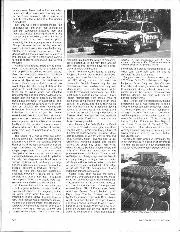

Rally Review - Corsica, June 1986
Tragedy repeated in Corsica For the second year in succession tragedy has struck the Lancia team whilst competing in the Tour of Corsica. Last year Italian driver Attilio Bettega was…
PREPARING YOUR OUT 1″ OARD
III. THE POSITION OF THE FIN.
WITH most outboardists, I regret to say, the fin is a kind of thing to stop the boat going sideways when cornering and is to be stuck on the bottom of the boat in the most convenient place, i.e., when there is a stout bit of wood to screw it to. In order to secure good steering qualities for any outfit it is essential that the position of the fin be carefully decided upon as it is the sole fulcrum about which the boat turns. It will clearly be seen that the further forward the fin is placed the greater will be the lateral movement of the aft planing surface across the water, thereby increasing the risk of the offside aft chine digging in the water, especially if the water is broken, with a result that the whole outfit goes over. Further in rough water the boats, when striking a wave, lift from the bow and if the fin is forrar’d of the step it will come clear or partially clear with comparatively little vertical movement, with a result that the effective lateral resistance is constantly varying, and when the turning point is permitted to move laterally in varying degrees, a very unsteady motion is imparted to the craft as a whole. Here then are two good reasons why the tendency should be to keep the fin aft. Another important point with regard to the fin position is whether a high or low geared steering is
desired. It will be found that the majority of racing car drivers favour high geared steering, for it makes the car feel ” tighter ” and permits one to place it with a greater nicety. So is my experience with hydroplanes, and therefore, I have another reason for keeping the fin well aft. By practical experiment it has been found by keeping the position of the fin aft that the craft remains much steadier on the straight, speed wobble, or whatever its water equivalent’s name may be, is absolutely
iffiminated. In my opinion the fin is best placed just about in line with the vertical, through the centre of gravity of the outfit complete with pilot, and this position is situated usually just about 6 inches behind the step.
Incidentally it is essential that the fin should be bolted (not screwed) dead fore and aft, or the craft will wander from the straight and narrow in an alarming fashion. It should be noted that the skin-friction of the fin and of the prop housing is considerable, and these parts should be kept well polished. This polishing will be greatly facilitated if, when removing the outfit from the water, these two items are wiped over with an oily rag— this is essential if the craft has been used in salt water, as the salt corrodes the aluminium.—M.